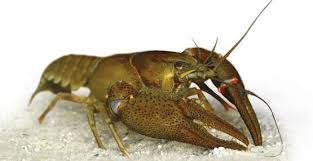(European) crayfish (Astacus astacus) are native freshwater crayfish.
 Previously everyone knew the crayfish. Where enough oxygen and shelters were in streams, rivers and lakes they were found. Unfortunately, oxygen is often supplanted by pollution. And poison accumulates in scavengers.
Previously everyone knew the crayfish. Where enough oxygen and shelters were in streams, rivers and lakes they were found. Unfortunately, oxygen is often supplanted by pollution. And poison accumulates in scavengers.
The crayfish is approximately 18 centimeter long from nose to tail and can weigh 200 even 300 grams in exceptional cases. The scissors can reach a length of ten centimeter. The animals are, if they get the chance, about 12 to 15 years old.
Crustaceans were easy to catch with smelling (little rotting) bait. And they could be preserved for a long time out of the water so they remain fresh long.
If you search the Internet, you can hardly find information, but a mountain of recipes. That says a lot.
I do not know if there are European crayfish found in the Low Countries any longer. The release of American lobsters brought a disease of which they are not, but European lobsters have succumbed.
When at the turn of the century a puddle in Limburg was opened for diving there swarmed lots of crayfish. After a month or two, the pool was well known by hobby divers. There were more and more divers, and fewer lobsters. One month later, there were fewer lobsters in the lake than on the menus of the restaurants nearby. And after a month it was over. Both in the pool as well as in the pan. Very sad. For a few dollars people robbing nature everywhere. Pathetic.
(Also, lobsters and crabs in the sea are easy to catch. Diver with fish traps and baskets can grab them too (in burrows, caves, wrecks) from behind. Pincers can crack your fingers.)
